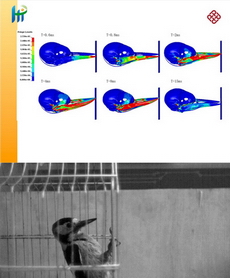|
|
|
|
|
|
|
Woodpeckers study unlocks the key to avoid head injury |
||
|
Woodpeckers study unlocks the key to avoid head injury
|
Jointly led by Prof. Zhang Ming of PolyU’s Department of Health Technology and Informatics and Prof. Fan Yubo of Beihang University, a pioneering study has unravelled the mystery of why the repeated tree-pecking motion of woodpeckers does not sustain any brain injury. Two synchronous high-speed video systems were used to observe the pecking motion of woodpeckers and a force sensor was used to measure the pecking force. The research findings showed that a combination of three factors at work has spared the injury of woodpeckers. First, the skulls of woodpeckers were protected by hyoid bone’s looping structures which serve like a “safety belt”. Secondly, the upper and lower halves of the birds’ beaks were uneven in length. This asymmetry lowered the impact of pecking force transmitted from the tip of the beak onto the brain. Thirdly, the “spongy” bone structure at different points in the skull helped distribute the incoming force, thereby protecting the brain. The researchers anticipated that more quantitative studies will have to be conducted before applying this bio-mechanism to the design of human protective devices and other industry design, e.g. helmets and other related products. Details>>
|
